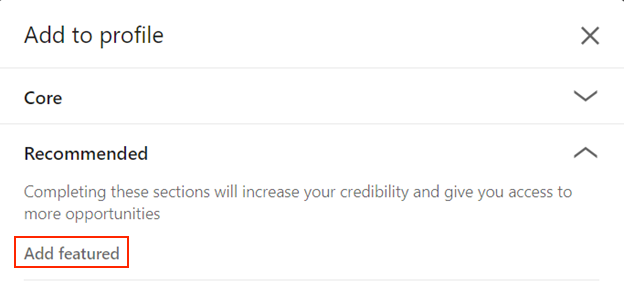As one of the largest networking platforms for job seekers, LinkedIn has over 800 million users and 58 million listed companies. Although your LinkedIn profile serves a different function than your resume, you may want to upload your document to your account.
This provides a different reading experience for recruiters and potential employers who take an interest in your profile, and enables you to apply for jobs even faster on the LinkedIn mobile application or desktop website. Throughout this guide, we’ll walk you through how to upload your resume to your profile and evaluate the pros and cons of including your resume.
How To Upload Your Resume to LinkedIn
Uploading your resume is easy. First, make sure you’re viewing your profile. Then, click the “Add a profile section” button underneath your number of connections. Select the “Recommended” drop-down menu and click “Add featured.”

Finally, you’ll upload your resume by clicking the + button and selecting “Add media.”

Should You Upload Your Resume to LinkedIn?
Depending on the situation, you may not wish to include your resume on your LinkedIn profile. While it has some benefits, such as making the application process more convenient, you may also find that your document contains sensitive information that you may not want to be publicly available.
The other concern for job seekers covertly looking for opportunities is that including their resume may tip off their current employer, which can have potentially disastrous ramifications. Job hunters not currently employed or open to their bosses about pursuing other opportunities won’t have these same concerns. They can upload the profile to enhance the efficiency of the application process.
Should Your LinkedIn Content Match Your Resume?
While you may find a fair amount of overlap between the resume and LinkedIn profile, avoid having all the content read the same across both mediums. The resume should always be in the third person. But you may want to use a first-person approach when building your LinkedIn profile. Because this is a social media networking site, you also have more freedom to speak on a more personal level than you would on a resume.
Include significant accomplishments from your career as you detail your work experience and add more insights into who you are. For instance, if you’re passionate about emerging trends within your space, adding a paragraph that provides insights into your expertise can help improve your branding as a thought leader in your industry.
Frequently Asked Questions About Adding a Resume to LinkedIn
How do you align your resume with LinkedIn?-
The key to crafting a compelling LinkedIn profile is incorporating key aspects of your resume without simply copying and pasting the content verbatim. Because LinkedIn has its own SEO algorithm, including bullet points with high-ranking keywords and industry terms is beneficial to maximize your visibility with recruiters.
That said, ensure that the information you provide doesn’t break any confidentiality agreements and has a different reading experience from the resume document. The LinkedIn profile needs to be viewed as an extension of your resume rather than simply an online carbon copy.
How do you format your resume on LinkedIn?-
When adding your resume content to the work experience section of your LinkedIn page, use a combination of bullet points and paragraphs. A brief summary of your experience at the top of each job will draw attention to your most impressive accomplishments and provide a different reading experience from your resume.
After four lines, the software will hide the remaining content unless the viewer clicks the See More button, so you can feel free to detail the rest of your content in bullet points. Use this opportunity to incorporate high-value industry terms and keywords to improve your visibility on the platform. Researching sample job postings on LinkedIn can be helpful here in identifying the correct words.
How do you download your LinkedIn profile as a PDF?-
Unless you’ve started building your work experience content on LinkedIn before creating your resume, downloading your profile as a PDF doesn’t have much purpose during the job search other than providing another way to assess your LinkedIn content.
Avoid sending a PDF of your LinkedIn to an employer, as the content is meant to be read differently and won’t help you generate traction as you apply for jobs on the open market. To download your LinkedIn as a PDF, select the Me icon on your profile page and click the More button in your introduction. Then save your LinkedIn profile in PDF format.
Craft your perfect resume in minutes
Get 2x more interviews with Resume Builder. Access Pro Plan features for a limited time!




